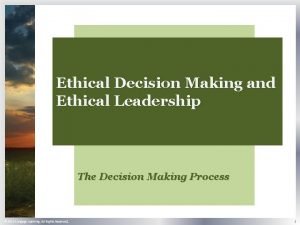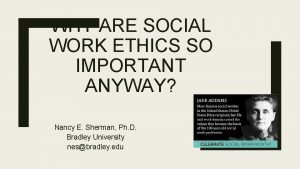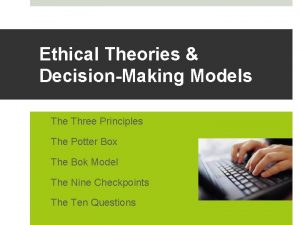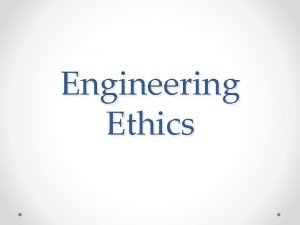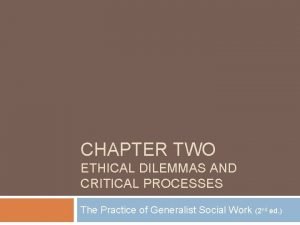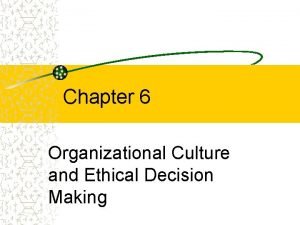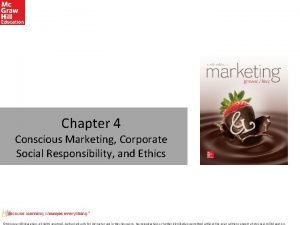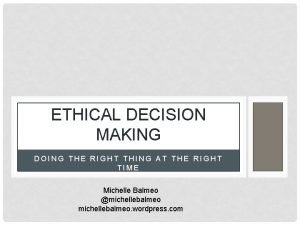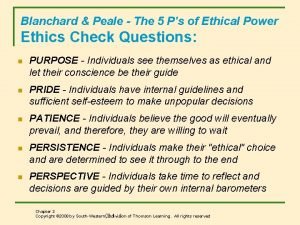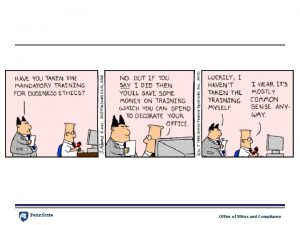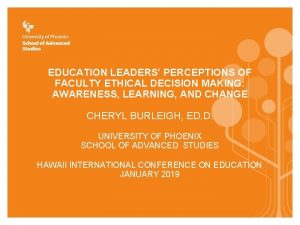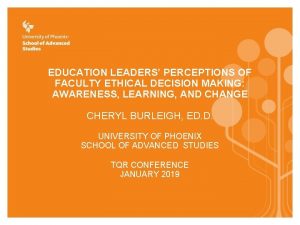EDUCATION LEADERSHIPS PERCEPTIONS OF FACULTY ETHICAL DECISION MAKING












- Slides: 12

EDUCATION LEADERSHIPS’ PERCEPTIONS OF FACULTY ETHICAL DECISION MAKING Dr. Cheryl Burleigh University of Phoenix

CONTEXT • International current events are bringing to the forefront the topics of ethics and ethical decision making. • Examine ethics in the context of education leadership • • Observations and awareness of faculty Ethical decisions within the classroom and the school community Reporting of issues that may be of ethical concerns Professional development opportunities • Role and relationship of education leaders to faculty

LITERATURE REVIEW • Ethics within the teaching profession • creating a culture and applied knowledge of ethics within the classroom (Campbell, 2003) • attention of the intangibles: morality and ethics (Campbell, 2003; 2008). • The Finnish teachers’ ethical sensitivity study (Kuusisto, Tirri, & Rissanen, 2012) examined teacher’s perceived ethical sensitivity based on • • training, reflection, years within the profession, and competence.

NEA CODE OF ETHICS ADOPTED BY THE NEA 1975 REPRESENTATIVE ASSEMBLY NATIONAL EDUCATION ASSOCIATION (NEA) PUBLIC EDUCATION/SCHOOLS PRINCIPLE I COMMITMENT TO THE STUDENT The educator strives to help each student realize his or her potential as a worthy and effective member of society. The educator therefore works to stimulate the spirit of inquiry, the acquisition of knowledge and understanding, and the thoughtful formulation of worthy goals. Shall Not 2. unreasonably deny the student's access to varying points of view. 3. deliberately suppress or distort subject matter relevant to the student's progress. 5. intentionally expose the student to embarrassment or disparagement. 6. on the basis of race, color, creed, sex, national origin, marital status, political or beliefs, family, social or cultural background, or sexual orientation, unfairly-Exclude any student from participation in any program Deny benefits to any student Grant any advantage to any student religious

EMERGING RESEARCH • Direct relationship of student and teacher interactions • ethical climate and • principles inclusive of trust and motivation (Schulte et al. , 2002; Demir & Karakus, 2015). • Hannah et al (2008) and Avolio et al (2009) encouraged those in positions of leadership to examine • current approaches of decision making, • evolve to go beyond expectations, and • welcome the challenges of meeting the demands of their school communities

RESEARCH METHOD & PARTICIPANTS • Exploratory Design Semi Structured Interview • San Francisco Bay Area; Northern California • Education Leaders representing schools Public Private(Secular and Non-Secular) Charter • Education Leadership: Minimum of 5 years experience Classroom teachers • Demographics male (70%), female (30%) identify as minority (50%) mean age 48

FINDINGS • Ethical Behavior • Climate • Classroom • Colleagues • Educational Leadership • Reporting of Issues • Status; Years at school; Rank in Department; Seniority • Unions • Trust • Professional Development • School Site and District • Universal Code of Ethics for Educators

EDUCATION LEADERS’ OBSERVATIONS AND PERCEPTIONS OF ETHICAL DECISION MAKING (EXPRESSED IN PERCENTAGE) 90 80 70 60 50 40 30 20 10 0 Ethical Behavior Climate Students Reporting Colleagues Ed Leadership Trust

CHALLENGES & SIGNIFICANCE • Developing a Universally accepted Code of Ethics for U. S. Educators Professional Standards applicable to all educational institutions and levels • U. S. Teacher Education Programs: Ethics in Education Coursework, Student Teaching, Professional Responsibility/Ethics Examination • State Department of Education and Commission on Teacher Credentials Professional development, credential, licensure • School Climate • Universally accepted standards for conduct in the • • classroom colleagues and leadership school community

CRITICAL QUESTIONS • Would a Universal Codes of Ethics for U. S. Educators help frame the role of ethical decision making for educators of all school types in the classroom, school site, and school community? • What role does a state’s department of education or commission on teacher credentialing play? Legislation, training, certification, examination? • What is the role of school districts in assuring an ethical climate exists within schools? • How can education leadership incorporate ethical perspectives into the school community? How would a new perspective foster a greater understanding of what is ethical ? Would such actions increase level of trust? • What teacher populations remain on the margins of receiving adequate professional development training in the understanding of ethics and ethical decision making?

REFERENCES Avolio, B. J. , Walumbwa, F. O. , & Weber, T. J. (2009). Leadership: Current events theories, research, and future directions. Annual Review of Psychology, 60, 421 -449. Campbell, E. (2003). The ethical teacher. Maidenhead, PA: Open University Press. Campbell, E. (2008). The ethics of teaching as a moral profession. Curriculum Inquiry, 38(4), 357 -385. Demir, S. , & Karakus, M. (2015). The Relationship between ethical climate and trust and motivation Levels of teachers and students. Educational Administration: Theory and Practice. 21(2), 183 - 212. Hannah, S. T. , Avolio, B. J. , Luthans, F. , & Harms, P. (2008). Leadership efficacy: Review and future directions. The Leadership Quarterly, 19(Yearly Review of Leadership), 669 -692. Kuusisto, E. , Tirri, K. , & Rissanen, I. (2012). Finnish teachers’ ethical sensitivity. Education Research International, 2012, 1 -10. NEA. (1975). Code of Ethics. Retrieved from http: //www. nea. org/home/30442. htm Schulte, L. E. , Thompson, F. , Talbott, J. , Luther, A. , Garcia, M. , Blanchard, S. , &. . . Mueller, M. (2002). The Development and Validation of the Ethical Climate Index for Middle and High Schools. The School Community Journal, 12(2), 117 -132.

CONTACT INFORMATION Dr. Cheryl Burleigh Associate Faculty, College of Humanities and Sciences Faculty Supervisor, College of Education Research Fellow-CPRE and Associate Faculty, School of Advanced Studies Certified Advanced Facilitator direct 925. 997. 0258 email cburleigh@email. phoenix. edu
 Ethical decision making and ethical leadership
Ethical decision making and ethical leadership Essential steps for ethical problem-solving
Essential steps for ethical problem-solving Ends based thinking
Ends based thinking 7 step ethical decision making model
7 step ethical decision making model Reamer's ethical decision making model
Reamer's ethical decision making model Organizational culture and ethical decision making
Organizational culture and ethical decision making What is an example of an ethical decision-making metric?
What is an example of an ethical decision-making metric? 7 step ethical decision making model
7 step ethical decision making model Kerridge’s ethical decision-making model
Kerridge’s ethical decision-making model Potter's box for ethical decision making
Potter's box for ethical decision making 5 p's of ethical power
5 p's of ethical power Ethical decision making
Ethical decision making Jnj credo hotline
Jnj credo hotline
